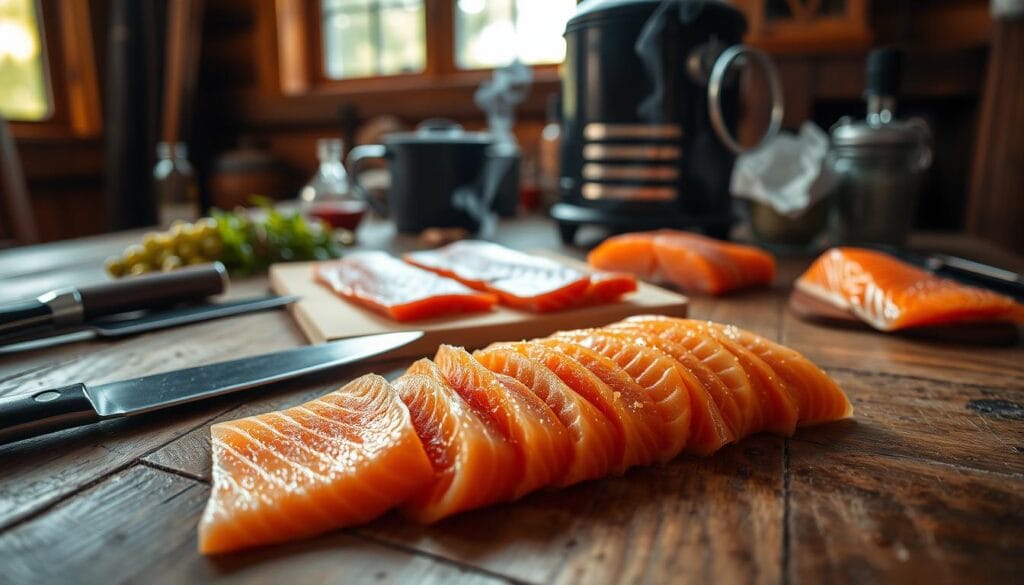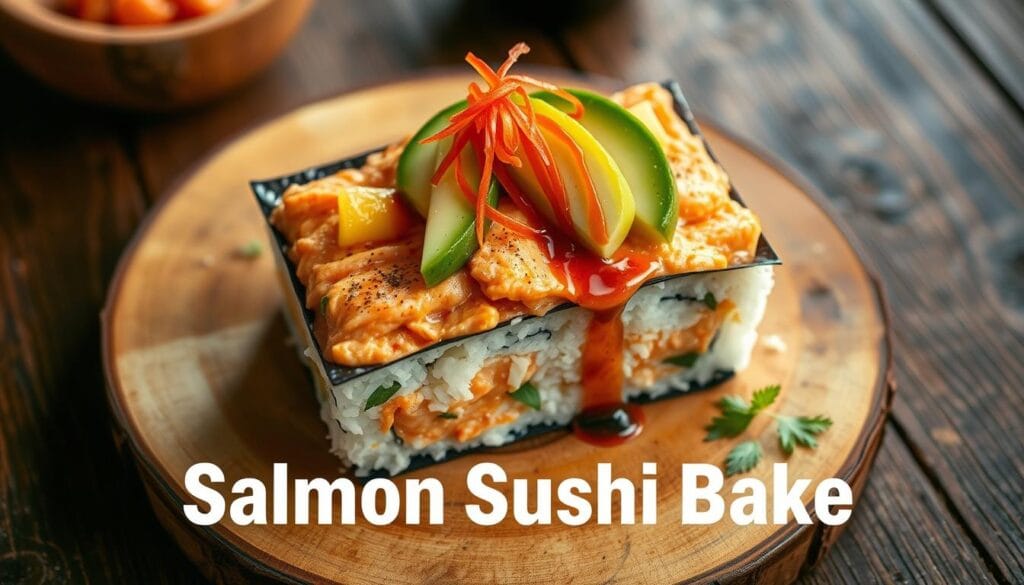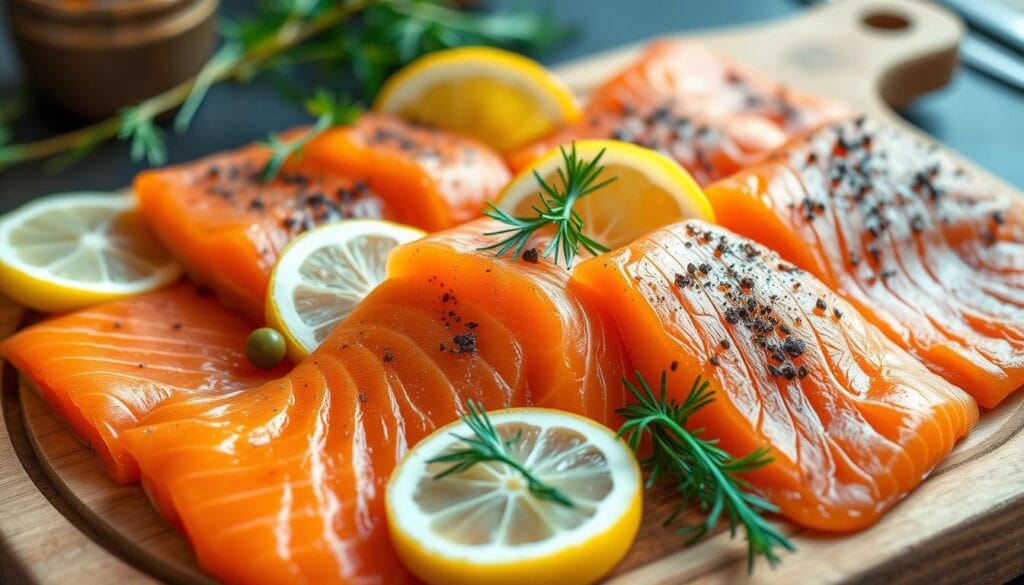The first time I tasted homemade smoked salmon, it was a game-changer. The flavor was rich and delicate, turning a simple meal into something special. Learning how to smoke salmon might seem hard, but with the right help, anyone can do it.
Smoking salmon is more than cooking—it’s a tradition that adds depth to the fish. It’s perfect for home cooks looking to improve their skills or food lovers wanting to try traditional methods. Smoking salmon is a rewarding experience that connects you to old culinary ways.
In this guide, you’ll learn all about smoking salmon. We’ll cover picking the right fish to mastering smoking techniques. Each step is explained clearly, making the process easy to follow.
Get ready to make delicious smoked salmon in your kitchen. Your taste buds are in for a treat as you explore new flavors and techniques.
Table of Contents
Understanding the Art of Smoking Salmon
Learning to make smoked salmon is a fun journey into the world of cooking. It involves mastering different smoking techniques. Salmon smoking turns fresh fish into a tasty treat with careful prep and temperature control.
Hot Smoking vs Cold Smoking
There are two main ways how to smoke salmon: hot smoking and cold smoking. These methods vary in temperature and cooking style:
- Hot Smoking: Cooks salmon at about 225°F, fully cooking the fish and adding smoky flavors
- Cold Smoking: Happens at lower temps (around 90°F), used to preserve flavors without fully cooking the fish
Benefits of Hot Smoking for Beginners
Hot smoking is great for beginners. It’s a simpler way how to smoke salmon, ensuring safety and easier learning.
- Faster cooking times
- More robust flavor development
- Reduced risk of bacterial growth
- Easier temperature control
Essential Equipment and Tools
How To smoke salmon well, you need basic gear. The right tools make the process more fun and consistent.
- Smoker or smoking device
- Digital meat thermometer
- Brining containers
- Wood chips for smoking
- Cooling racks
Choosing the Right Salmon for Smoking
When making a tasty smoked salmon, picking the right salmon is key. Not all salmon is the same, and some are better for smoking than others.
For the best smoked salmon, choose salmon with lots of fat. Atlantic and King salmon are great choices. They have a rich, buttery taste and stay moist while smoking.
- Atlantic salmon: Consistently high fat content
- King (Chinook) salmon: Premium quality with exceptional flavor
- Sockeye salmon: Leaner option with intense red color
When buying salmon for your recipe, keep these tips in mind:
- Freshness: Choose fish with firm, bright flesh
- Smell: Fresh salmon should smell mildly of the ocean
- Color: Bright, even color means it’s of good quality
| Salmon Variety | Fat Content | Flavor Profile | Best for Smoking |
|---|---|---|---|
| Atlantic | High | Mild, buttery | Excellent |
| King | Very High | Rich, intense | Outstanding |
| Sockeye | Medium | Strong, distinctive | Good |
It’s also important to think about sustainability. Wild-caught salmon from eco-friendly fisheries tastes great and is good for the planet. Your local fishmonger can guide you to the best salmon for your dish, ensuring top quality.
Essential Equipment for Smoking Salmon
Getting ready how to smoke salmon means picking the right tools. Whether you’re new or have smoked before, the right gear makes it easier and more fun.
Your smoker is key when you start smoking salmon. Each smoker type has its own benefits for making tasty smoked fish.
Types of Smokers for Salmon
- Electric Smokers: Great for beginners, they keep the temperature steady
- Charcoal Smokers: Give a real smoky taste for classic smoking
- Propane Smokers: Easy to use for those who love cooking outside
Temperature Control Tools
Keeping the temperature just right is key for smoking salmon. Get tools that help you do this well:
- Digital meat thermometer
- Instant-read probe thermometer
- Built-in smoker temperature gauge
Additional Supplies for Smoking Salmon
Here’s what you need how to smoke salmon:
- Food-grade brining containers
- Sharp fillet knife
- Cutting board
- Wood chips or chunks
- Aluminum foil
- Serving platters
Choosing the right equipment means you’re ready for a great salmon smoking experience.
How to Smoke Salmon: Step-by-Step Process
Learning to make smoked salmon is a detailed process. It starts with knowing the key steps to turn fresh fish into a tasty treat.
The steps to make smoked salmon are crucial:
- Salmon Selection: Pick fresh, high-quality salmon with firm flesh and few bones
- Preparation: Clean and trim the salmon, removing scales or bones
- Brining: Make a salt and sugar mix to add flavor and keep the fish fresh
- Pellicle Formation: Let the salmon dry to create a tacky surface for smoke to stick to
- Smoking: Cook the salmon at set temperatures using your chosen method
Each step is important for the salmon’s smoky flavor. You need patience and care to make it look and taste great.
For beginners, keep the temperature steady and watch the salmon’s moisture. With time, you’ll make smoked salmon as good as any restaurant’s.
Preparing the Perfect Brine Solution
Brining is key to making delicious smoked salmon. It turns regular fish into a tasty treat that seafood lovers will adore.
Knowing the science of brining ensures moist, flavorful salmon. A good brine seasons the fish and keeps it moist while smoking.
Basic Brine Recipe
Making a basic smoked salmon brine is easy. Here’s a simple recipe for home smokers:
- 4 cups cold water
- 1/4 cup kosher salt
- 1/4 cup brown sugar
- 2 tablespoons black peppercorns
Brining Duration Guidelines
| Salmon Weight | Brining Time |
|---|---|
| 1 pound | 60-90 minutes |
| 2-3 pounds | 2-3 hours |
| 4-5 pounds | 4-5 hours |
Optional Flavor Enhancements
Add these creative touches to your brine:
- Citrus zest for bright notes
- Fresh dill or rosemary
- Crushed garlic cloves
- White wine or apple cider
“The secret to great smoked salmon is in the brine. Take your time and let the flavors develop.” – Professional Smoker
After brining, rinse and pat dry your salmon. This step is crucial for a great pellicle and quality smoke absorption.
Creating the Essential Pellicle
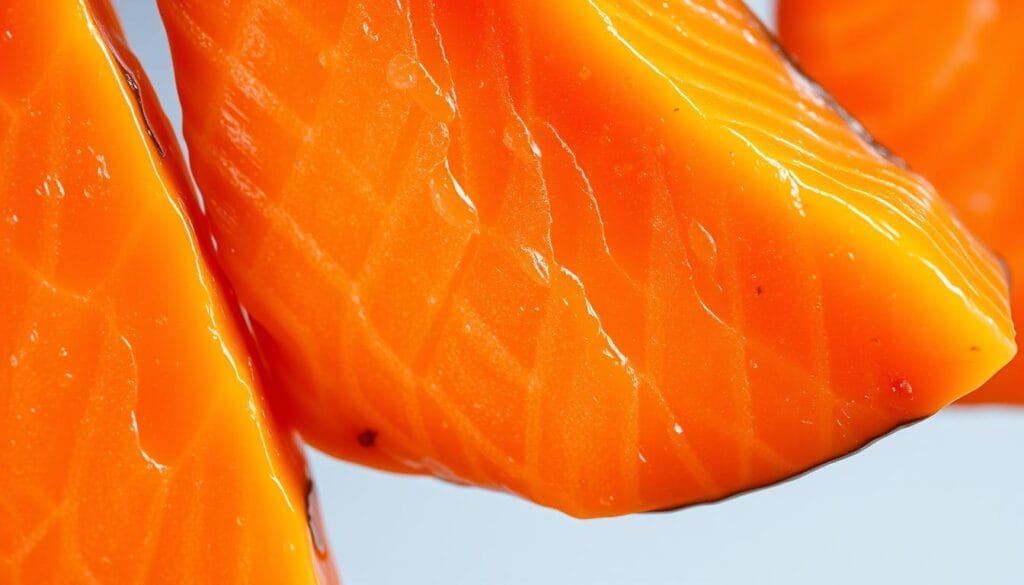
Learning how to smoke salmon starts with making a pellicle. This tacky protein layer is key for great smoking results. It’s often missed by beginners.
To get a perfect pellicle, dry the salmon well after brining. Use paper towels to pat it dry. Then, put the salmon on a wire rack in a cool, airy spot.
- Ensure room temperature is around 50-60°F
- Allow salmon to air dry for 1-3 hours
- Look for a slightly shiny, sticky surface
The pellicle acts like a magnet for smoke particles. It helps your salmon soak up more flavor. It also keeps moisture in, so the fish stays juicy.
“A well-formed pellicle is the secret to professional-quality smoked salmon” – Culinary Experts
Creating the pellicle takes time. Hurrying can lead to uneven flavor and less tasty salmon. Aim for a tacky surface that traps smoke well.
Pro tip for how to smoke salmon: If it’s too humid, a small fan can help. It improves air flow and speeds up pellicle formation.
Selecting the Right Wood for Smoking
Choosing the perfect wood is key to making your smoked salmon recipe stand out. The right wood can take your salmon from good to amazing. It adds depth and character to your dish.
Different woods give your smoked salmon unique flavors. Some woods pair better with salmon than others. This makes your meal unforgettable.
Best Wood Types for Salmon
- Alder Wood: Traditional choice for salmon, providing a light and sweet flavor
- Apple Wood: Offers a mild, fruity smoke that enhances salmon’s natural taste
- Oak Wood: Delivers a stronger, more robust smoky flavor
Wood Preparation Methods
Getting your wood ready is crucial for a great smoked salmon recipe. Soak wood chips in water for 30 minutes before smoking. This makes them burn longer and adds moisture.
| Wood Type | Flavor Intensity | Best For |
|---|---|---|
| Alder | Light | Delicate fish like salmon |
| Apple | Mild | Subtle flavor enhancement |
| Oak | Strong | Bold flavor profiles |
Smoke Intensity Control
To control smoke intensity, watch the wood amount and air flow. Start with small wood chips to avoid overpowering the salmon’s taste.
Pro tip: Less is more when smoking salmon. You want to enhance, not mask, the fish’s delicate taste.
Temperature Control and Timing
Getting the smoked salmon internal temp right is key to a tasty and safe dish. The correct temperature makes sure your salmon is cooked just right. It keeps its rich flavor and tender texture.
When smoking salmon, focus on two important temperature ranges:
- Smoker temperature: Keep it between 225°F and 250°F
- Salmon internal temperature: Aim for 145°F for safety
You’ll need a good meat thermometer for precise temperature control. Stick the thermometer into the thickest part of the salmon for an accurate reading. Since smokers vary in heat distribution, rotate your fish halfway through to cook evenly.
The smoking time varies based on several factors:
- Thickness of the salmon fillet
- Smoker type and consistency
- Desired smokiness level
A medium-sized salmon fillet usually takes 2-3 hours to reach 145°F. Always check the temperature for food safety, not just the cooking time.
Pro tip: Let your smoked salmon rest for 10-15 minutes after cooking. This allows the juices to redistribute, making it moist and flavorful.
Avoiding Common Smoking Mistakes
Learning to make smoked salmon means knowing how to avoid common mistakes. These errors can ruin your dish. They are especially tricky for beginners.
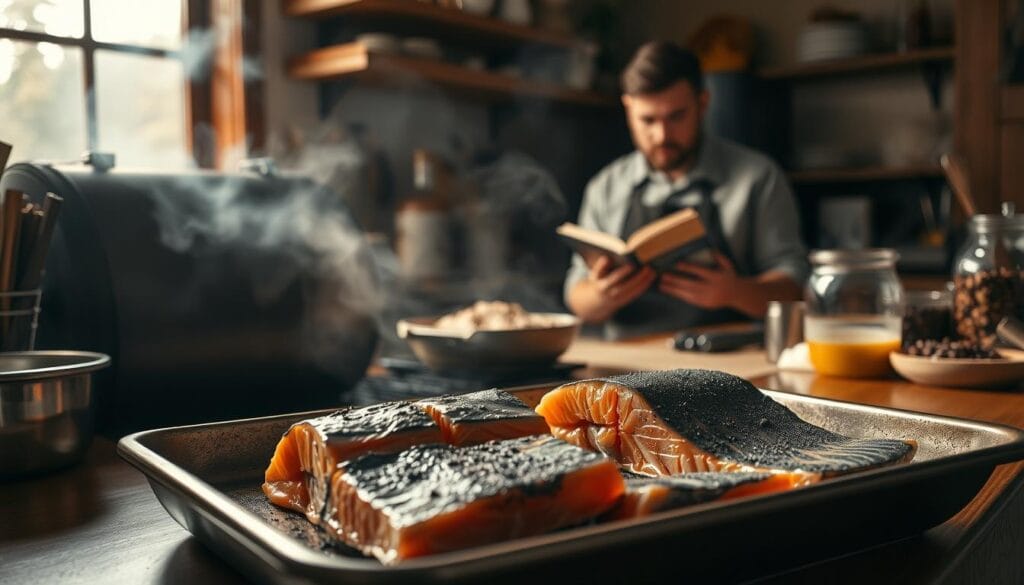
Smoking salmon is an art that needs precision and care. By learning from common mistakes, you can make perfect smoked salmon every time.
Temperature Challenges in Salmon Smoking
Temperature control is key when smoking salmon. Too much heat can make the salmon dry and tough.
- Maintain consistent smoker temperature between 175-225°F
- Use a reliable digital thermometer for accurate readings
- Avoid sudden temperature fluctuations
Moisture Management Techniques
Controlling moisture is crucial for smoking salmon. You want it to be just right, not too dry or too wet.
| Moisture Issue | Prevention Strategy |
|---|---|
| Overly Dry Salmon | Reduce smoking time, use lower temperatures |
| Too Moist Salmon | Ensure thorough pat-drying before smoking |
Timing Precision in Salmon Smoking
Timing is everything when smoking salmon. Overcooking makes it dry and tough, while undercooking is unhealthy.
“Patience is the secret ingredient in perfect smoked salmon.” – Professional Chef
Keep track of how long you smoke the salmon. It usually takes 2-4 hours, depending on its thickness and how done you want it.
Testing for Doneness
It’s important to know when smoked salmon is done. You want it to be 145°F inside. This ensures it’s safe to eat and tastes great.
Experts say to use a meat thermometer for the best results. Stick it into the salmon’s thickest part. This way, you get an accurate reading.
- Check temperature at the salmon’s thickest point
- Look for an internal temp of 145°F
- Verify the fish flakes easily with a fork
There are other ways to check if salmon is done. Look for:
- A rich, deep orange-pink color
- Translucent, moist appearance
- Smooth, uniform texture
| Doneness Indicator | Description |
|---|---|
| Internal Temperature | 145°F |
| Texture | Flakes easily, remains moist |
| Color | Deep orange-pink |
Pro tip: Let your smoked salmon rest for 3-5 minutes after cooking. This helps keep it juicy and flavorful.
Storage and Preservation Methods
Keeping your homemade smoked salmon fresh is key. The right storage methods help keep it safe and tasty. Follow these steps to enjoy your smoked salmon for a while.
For short-term storage, the fridge is your best friend. Wrap the fish in plastic wrap or use an airtight container. This way, your smoked salmon can last up to two weeks.
- Use clean, airtight containers
- Keep refrigerator temperature below 40°F
- Store in the coldest part of the refrigerator
Freezing is great for longer storage. Vacuum sealing protects against freezer burn. It keeps the flavor and texture just right.
Freezing guidelines for smoked salmon:
- Wrap tightly in freezer-safe packaging
- Remove as much air as possible
- Label with the date of freezing
- Store at 0°F or below
Pro tip: Frozen smoked salmon can maintain its quality for up to three months when properly stored.
Watch for signs of spoilage like bad smells, sliminess, or color changes. If you’re unsure, it’s best to throw it away. This way, you can enjoy your smoked salmon for weeks.
Conclusion
Learning how to smoke salmon is a fun skill that turns a simple fish into a tasty treat. With time and effort, you’ll master the techniques that make your smoked salmon stand out. Every try will help you get better and understand the smoking process more.
Smoking salmon at home opens up a world of creativity in cooking. You can try different wood chips, brine recipes, and smoking methods to find your favorite flavors. Smoked salmon is great for many dishes, making it a valuable skill for anyone who loves to cook.
Getting good at smoking salmon takes time and practice. Start with the basics, get good equipment, and don’t be afraid to try new things. Your skills will grow with each batch, and you’ll soon make smoked salmon that wows everyone. Enjoy the journey, learn a lot, and enjoy the tasty results of your efforts.
Smoking salmon at home is a rewarding and tasty experience, whether for a special meal or to learn a new skill. Your new knowledge lets you make dishes that show off your cooking talent and love for great food.
Did you like this recipe ?
There are no reviews yet. Be the first one to write one.
